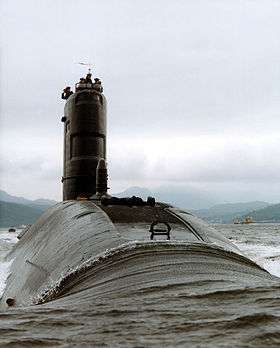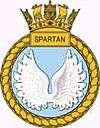HMS Spartan (S105)
 HMS Spartan in 1993 | |
| History | |
|---|---|
| Name: | HMS Spartan |
| Operator: | Royal Navy |
| Ordered: | 7 February 1976 |
| Builder: | Vickers |
| Laid down: | 26 April 1976 |
| Launched: | 7 May 1978 |
| Commissioned: | 22 September 1979 |
| Decommissioned: | January 2006 |
| Identification: | Pennant number: S105 |
| Motto: | Courage With Great Endurance |
| Fate: | Paid off |
| Badge: |
 |
| General characteristics | |
| Class and type: | Swiftsure-class submarine |
| Displacement: | 4,900 tonnes (dived) |
| Length: | 82.9 m (272 ft 0 in) |
| Beam: | 9.8 m (32 ft 2 in) |
| Draught: | 8.5 m (27 ft 11 in) |
| Propulsion: | Rolls-Royce pressurised water nuclear reactor (PWR1) |
| Speed: | In excess of 20 knots (37 km/h), dived |
| Complement: | 116 officers and men |
| Armament: |
|
HMS Spartan was a nuclear-powered fleet submarine of the Royal Navy's Swiftsure class. Spartan was launched on April 7, 1978 by Lady Lygo, wife of Admiral Sir Raymond Lygo. The boat was built by Vickers Limited Shipbuilding Group (now a division of BAE Systems) at Barrow-in-Furness in Cumbria, England. She was decommissioned in January 2006.
Operational history
Spartan was ordered to sail south for the Falkland Islands two days before the Argentine invasion of the islands on 30 March 1982. Spartan was the first ship to arrive in the islands and began to enforce a 200-mile (370-km) maritime exclusion zone imposed by the British. Shortly after, Spartan sighted Argentine merchant shipping mining the harbour at Stanley, but was not ordered to attack. This was partly due to British concerns about escalating the war too early, but also to avoid scaring off more lucrative targets such as the Argentine aircraft carrier Veinticinco de Mayo.On 1 May, Spartan was marking the 25 De Mayo, from just outside the Argentinian 12 mile limit, when the SSN was ordered away by the Northwood fleet command in England,[1] rejecting, the strong view of the task force commander, Admiral Woodward. He considered as the highest ranking naval officer in the area, he should control the RN, SSNs in the area, and potentially faced losing the war, by the lack of local control in the battle zone [2] In the following days 25 de Mayo was therefore able to move, and almost launched a A-4Q Skyhawk attack from much closer range than possible from Argentinian airfields and unchecked by the British nuclear submarines frequently operated a/s aircraft and helicopters well outside the territorial limit. Unlike HMS Conqueror, Spartan did not fire in anger during the Falklands War, though she did provide valuable reconnaissance to the British Task Force on Argentine aircraft movements.
In November 2010, it was reported in Hansard that Spartan had run aground off the west coast of Scotland in October 1989.[3]
In 1999, Spartan was fitted with Tomahawk cruise missiles.
References
- ↑ A. Gordon. The Rules of the Game. Jutland and the British Naval Command. US Naval Institute. Annapolis. Maryland (1996)
- ↑ A. Gordon. The Rules of the Game. Jutland & Naval Command. (2007)Penquin.UK, p185-8
- ↑ http://www.publications.parliament.uk/pa/cm201011/cmhansrd/cm101102/text/101102w0001.htm#10110298000032